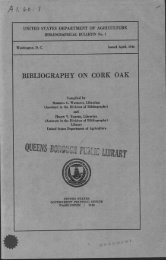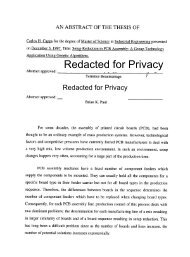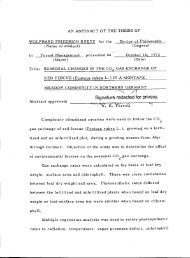In vitro anaerobic trinitrotoluene (TNT) degradation with rumen fluid ...
In vitro anaerobic trinitrotoluene (TNT) degradation with rumen fluid ...
In vitro anaerobic trinitrotoluene (TNT) degradation with rumen fluid ...
Create successful ePaper yourself
Turn your PDF publications into a flip-book with our unique Google optimized e-Paper software.
1.3 <strong>TNT</strong> <strong>degradation</strong> under <strong>anaerobic</strong> conditions<br />
The <strong>degradation</strong> of explosives under <strong>anaerobic</strong> conditions has been intensively<br />
studied <strong>with</strong>in past the few years. Various microorganisms, including denitrifing,<br />
sulfate reducing, methanogenic, and specific enzymes, were applied to examine the<br />
feasibility of explosives <strong>degradation</strong> under <strong>anaerobic</strong> conditions. Principal findings are<br />
as summarized below.<br />
McCormick et al. (18) investigated <strong>TNT</strong> reduction by cell-free extracts, resting<br />
cells, and growing cultures. The cell-free extracts and resting cells reduced three nitro<br />
groups to corresponding amino groups under strctly <strong>anaerobic</strong> conditions. Growing<br />
cultures of V. alkalescens and E. colt produced 2,4DA6NT. <strong>In</strong> the case of<br />
nitrotoluene, the reduction of a para-positioned nitro group was followed by the<br />
ortho-positioned group. The nitro reductase separated from V. alkalescens consisted<br />
of hydrogenase and ferredoxin-like materials, but whether the nitro reduction took<br />
place solely via hydrogenase or ferredoxin was not conclusively demonstrated.<br />
Boopathy et al. (5) examined the <strong>anaerobic</strong> removal of <strong>TNT</strong> under different<br />
electron accepting conditions in a soil-bacterial consortium. Under nitrate reducing<br />
conditions, 82% of the <strong>TNT</strong> was removed from contaminants <strong>with</strong> 100 ppm of <strong>TNT</strong>.<br />
Under sulfate reducing conditions, 30% of 100 ppm was removed. Using CO2 as an<br />
electron acceptor, 35 % of 100 ppm <strong>TNT</strong> was removed. <strong>In</strong> these experiments, <strong>TNT</strong><br />
did not serve as a carbon or primarily energy source, but its removal was achieved by<br />
co-metabolism <strong>with</strong> the energy source. The <strong>TNT</strong> intermediate reductions were<br />
4A26DNT and 2A46DNT, wherein the former was predominant.<br />
9














